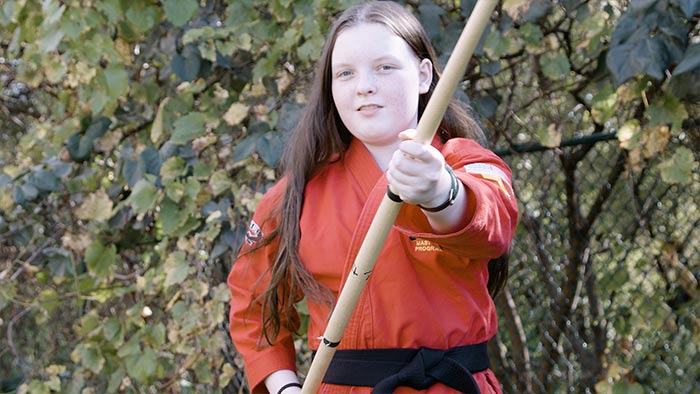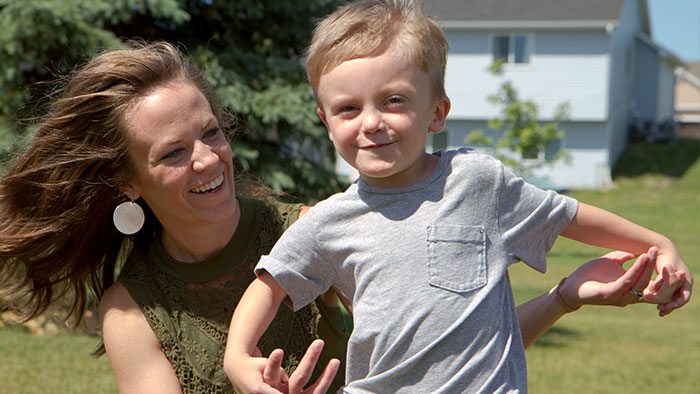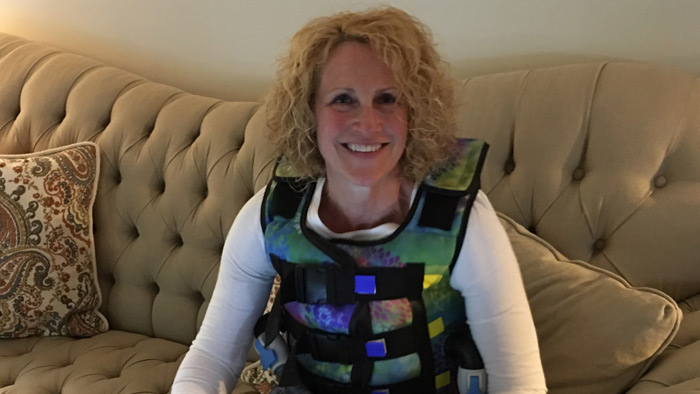Breathe easier with our solutions and support
Philips InCourage vest therapy
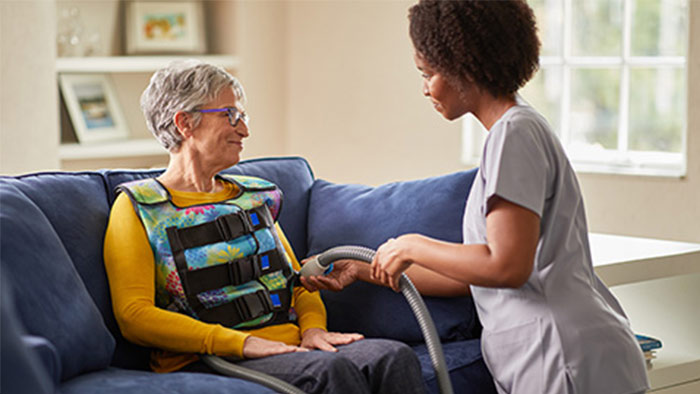
Vest therapy is a safe,1,2 effective,3,6 non-invasive, 7 non-pharmacological7 way to clear excess mucus from lungs and airways. With consistent, daily vest therapy, patients may experience fewer pneumonias and hospitalizations8,10 and better results on pulmonary function tests.11,12
Active venting – an innovation unique to the Philips InCourage system – is designed to let users take deep breaths during therapy to enhance comfort and help encourage treatment adherence.
Philips Respironics CoughAssist T70
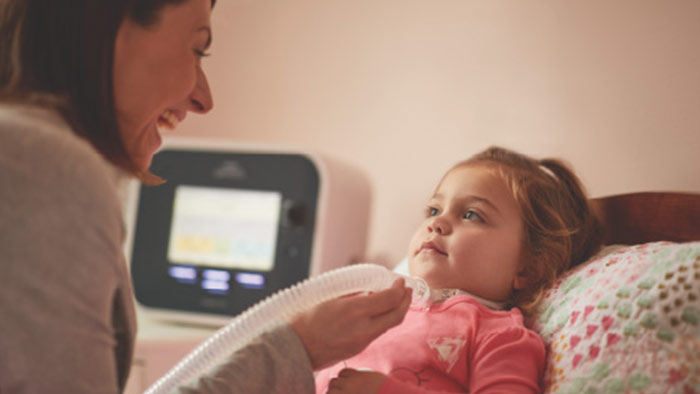
CoughAssist T70 is an effective, comfortable, non-invasive airway clearance solution for adult and pediatric patients who are unable to cough or clear secretions effectively CoughAssist requires no coordinated technique or glottis control, making it a viable option for patients with impaired muscle control. After using CoughAssist, patients report it is “easier to breathe.” Documented results include a decrease in acute illness-related episodes,14,15 among other benefits.
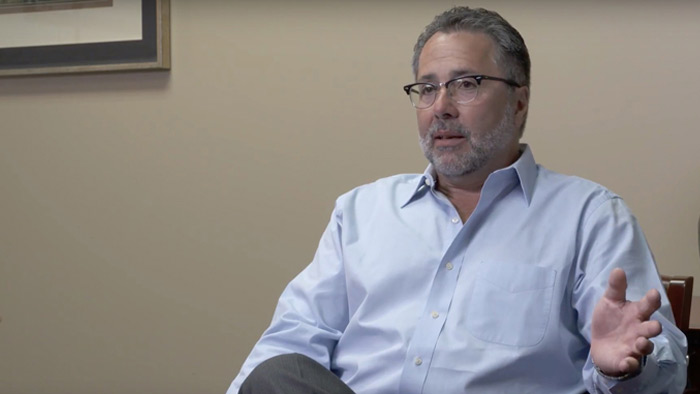
Airway clearance is a foundational therapy for patients with chronic lung disease. If you just focus on antibiotic therapy for these patients, you have this cycle in and out of the doctor’s office and hospital. Once you address that issue with appropriate intervention, you break that cycle.”
Frederic D. Seifer, MD, Pulmonologist, RespirTech clinical advisor
Stories
Jordan
With help from InCourage vest therapy, Jordan, a teenager with CF plays the flute and has earned a black belt in karate.
Gavin Born with neurological disorders and tracheomalacia, Gavin uses InCourage vest therapy to enhance his quality of life.
Autum Autum battled repeated lung infections from COPD and bronchiectasis for years until InCourage vest therapy helped change her quality of life.
Jordan
With help from InCourage vest therapy treatments, Jordan swims competitively, plays the flute and has earned a black belt in karate.
Gavin Born with neurological disorders and tracheomalacia, Gavin uses InCourage vest therapy to enhance his quality of life.
Autum Autum battled repeated lung infections from COPD and bronchiectasis for years until InCourage vest therapy helped change her quality of life.
References
1. Brierley S, Adams C, Suelter J, Gooch T, Becker B. Safety and tolerance of high-frequency chest wall oscillation (HFCWO) in hospitalized critical care patients. Respir Care 2003; 48 (11): 1112. (ABSTRACT) Note: Observational study of 73 critical care/post-surgical patients treated with HFCWO. 2. RespirTech Post Risk Review RAR10001v12 3. Nicolini A, Cardini F, Landucci N, Lanata S, Ferrari-Bravo M, Barlascini C. Effectiveness of treatment with high-frequency chest wall oscillation in patients with bronchiectasis. BMC Pulm Med. 2013;13:21. Note: 37 BE patient study comparing HFCC, OPEP or no-ACT. 4.Plioplys AV, Lewis S, Kasnicka I. Pulmonary vest therapy in pediatric long-term care. J Am Med Dir Assoc 2002;3:318-321. Note: Study of 7 quadriplegic cerebral palsy patients, 4 having epilepsy. 5. Lechtzin N, Wolfe LF, Frick KD. The Impact of High-Frequency Chest Wall Oscillation on Healthcare Use in Patients with Neuromuscular Diseases. Annals of the American Thoracic Society 2016;13(6):904-909. Note: 426 patients NMD patients. 6. Barto T, et al. Registry Outcomes for HFCWO Vest Therapy in Adult Patients with Bronchiectasis. Poster presented at: Am Thor Soc Intern Confer; 15 May 2016; San Francisco, Calif. Note: 2596 BE patient registry study comparing hospitalizations, antibiotic use and self-reported QOL metrics before and after HFCWO therapy. 7. Warwick WJ and Hansen LG Chest Compression Apparatus [Patent] : 6958046. – US, Oct. 25, 2005. 8. Giarraffa P, Berger KI, Chaikin AA, Axelrod FB, Davey C, Becker B. Assessing efficacy of high-frequency chest wall oscillation in patients with familial dysautonomia. CHEST 2005;128:3377-3381. Note: Year-long study of 15 patients with pulmonary disease due to Riley-Day syndrome. 9. Landon CG, W.; Evans, J. Airway Clearance Therapy Utilizing High-Frequency Chest Wall Oscillation for Medically Fragile Children. Poster Session at the Annual Meeting of the American Medical Directors Association, March 2002, San Francisco, CA 2002: (POSTER). Note: 15 patient study comparing pre/post HFCWO therapy use. 10. Plioplys AV, Lewis S, Kasnicka I. Pulmonary vest therapy in pediatric long-term care. J Am Med Dir Assoc 2002;3:318-321. Note: Study of 7 quadriplegic cerebral palsy patients, 4 having epilepsy. 11. Warwick WJ, Hansen LG. The long-term effect of high-frequency chest compression therapy on pulmonary complications of cystic fibrosis. Pediatr Pulmonal 1991; 11:265-271. Note: 16 CF patient study comparing pulmonary function following CPT to HFCC therapy. 12. Arens R, Gozal D, Omlin KJ, Vega J, Boyd KP, Keens TG, Woo MS. Comparison of high-frequency chest compression and conventional chest physiotherapy in hospitalized patients with cystic fibrosis. Am J Repir Crit Care Med 1994; 150: 1154-1157. Note: 50 CF patient study comparing conventional CPT to HFCC. 13. Milla CE, Hansen LG, Weber A, Warwick WJ. High-Frequency chest compression: effect of the third generation compression waveform. Biomed Instrum Technol 2004; 38:322-328. Note: 8 CF patient study comparing triangular vs. sine waveform technology. 14. Garstang SV, Kirshblum SC, Wood KE. “Patient preference for in-exsufflation for secretion management with spinal cord injury.” J Spinal Cord Med 2000;23(2)80-85.
15. Liszner K, et al. “CoughAssist Strategy for Pulmonary Toileting in Ventilator-Dependent Spinal Cord Injured Patients” Rehabilitation Nursing 2006;31:218-221.

